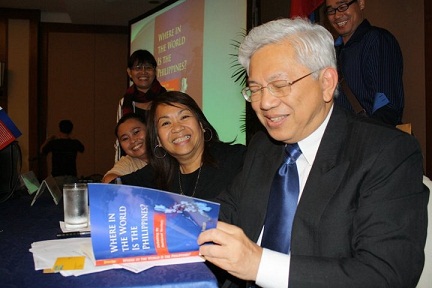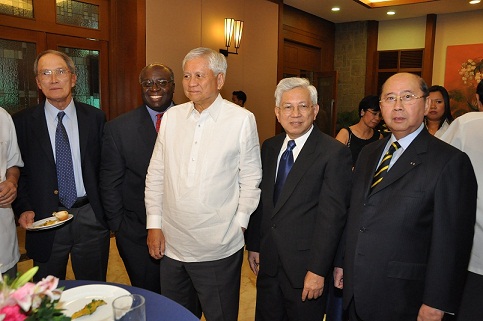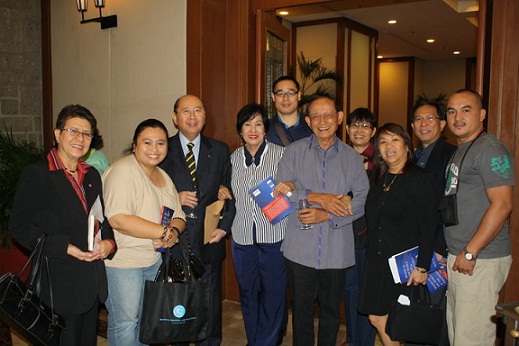Another article on the book: http://ph.yfittopostblog.com/2011/01/13/diplomat-rodolfo-c-severinos-book-takes-on-national-territory-debate/

Severino unselfishly shares his vast knowledge about foreign relations in an engaging way that makes what is generally regarded as an esoteric and intimidating topic easily understandable.This enviable skill of his is again evident in his latest book, “Where in the world is the Philippines?”
The book, published by the Carlos P. Romulo Foundation and the Institute of Southeast Asian Studies in Singapore is about the ambiguity of the country’s territorial boundaries which he said has far reaching effects on people’s lives and communities.
The ambiguity is ironic because, he said, the Philippines is the only country that defines its national territory in its Constitution.
The book, expectedly, tackles the contentious issues of Sabah and the Spratlys. It does not provide direct solutions to the conflicts.
Former foreign secretary Roberto R. Romulo said, “Those of us who know something about Philippine history and public affairs, know only too well how issues, long buried in the past, can unleash debates that are endless and exhausting.”
He said perhaps that was really Severino’s intent. “He means to waken public and national interest in an issue that has been consigned to the recesses of memory and the back-burners of government files.,”

The book goes back to the time when colonial powers – Spain, the United States, and both of them together – and by the pre-independence Philippines, including in the 1935 Constitution, took steps to define the extent of the Philippines’ territory and jurisdiction, unilaterally and through agreements with other countries taking into consideration the difficult relationship of the Muslim Filipinos with the colonial powers and with the rest of the country.
One hundred twenty three pages after of well-researched discussion, Severino urges Philippine policy makers to make up their collective minds, which he admits is something easier said than done, on:
• The waters between the baselines and the Treaty of Paris limits;
• Whether considering those waters as other than territorial waters would require a constitutional amendment;
• How to regard the Sulu Sea and the Moro Gulf and whether doing away with their internal-waters status would require a constitutional amendment;
• Whether and where to designate archipelagic sea lanes;
• Whether, when and where to make to the UN submissions on the country’s extended continental shelves other than the one that it has already done;
• Whether to highlight the regime of islands declared for Scarborough Shoal and the land features of the South China Sea that the Philippines claims;
• Whether to urge publicly China and Vietnam similarly to declare regimes of islands for the land features of the South China Sea that they claim; and
• What the Philippines should do about its Sabah claim.

“Not resolving boundary issues would continue to tie the hands of Philippine negotiators in bargaining with neighboring states on the delimitation of maritime boundaries. It would, moreover, prevent the country from entering into joint-development schemes that would be beneficial to itself and its people in areas that are disputed but where the Philippine Constitution or Philippine laws reserve “exclusively to Filipino citizens” the “use and enjoyment” of “the nation’s marine wealth in its archipelagic waters, territorial sea, and exclusive economic zone”.
Severino, who had served as Philippine ambassador to Malaysia, said further the maintenance of the Philippine claim to parts of North Borneo remains a thorn in Philippine-Malaysian relations and hampers the operation of cooperative schemes involving Sabah, like the Brunei Darussalam-Indonesia-Malaysia-Philippines East ASEAN Growth Area (BIMP-EAGA), which ties together all of Brunei Darussalam, eastern Indonesia, East Malaysia (Sabah and Sarawak), and Mindanao, Sulu and Palawan.
“It prevents the Philippines from setting up a proper consulate in Sabah from which to extend assistance to the hundreds of thousands of Filipinos there. It also withholds from the heirs of the Sultan of Sulu and/or the wider Sulu community whatever monetary compensation Malaysia offers in return for the withdrawal of the Philippine claim,” he said.
During the open forum, former Solicitor General Estelito Mendoza, who was a member of the Philippine contingent who drafted the United Nations Convention on the Law of Sea, suggested to Severino to send a copy of the book to President Aquino. He said to make sure that it is not voluminous because, “If it is thick, he is not going to read it.”
Thanks for this Ellen.
Have actually asked my sister to get me 4 copies of this book, 3 of which I shall give away to a friend in Malaysia and to two others in the EU.
Incidentally, Ellen, was wondering if there was anything in the book that could be used by other countries (or their officials) with whom the Philippines has a standing dispute, you know, anything that could compromise RP’s stand?
I was actually thinking of sending it to Najib but I guess Mr Severino will be sending him one himself? If he is, I might send it to Marina Mahathir, who incidentally owns a few high-end condo buildings (not just units but buildings) in Kota Kinabalu.
This is an FB note from Amb. Severino:
Thank you all, Ellen et al, for the kind words. If one wants the hard copy of the book or just a chapter, please go to http://bookshop.iseas.edu.sg/. The book will also be on Amazon, I just don’t know when. You might want to look at our Web site, http://www.aseanstudiescentre.org/. We are also on Facebook, in which you might want to become our fan, and on Twitter.
Bakit wala yung kuha kasama si FVR? Di ba tumalab ang camera kay tabako? Sarap ng bungisngis ninyo nila Charmaine a samantalang si RR Romulo di ko pa yata nakitang ngumiti.
Ok, I’ll post the photo with FVR.
I hope Noynoy won’t let Ochoa review the book.
During the open forum, former Solicitor General Estelito Mendoza, who was a member of the Philippine contingent who drafted the United Nations Convention on the Law of Sea, suggested to Severino to send a copy of the book to President Aquino. He said to make sure that it is not voluminous because, “If it is thick, he is not going to read it.”
Loko itong si Mendoza. Nagsasabi ng totoo.
Pwede ba na si Sir Severino ang ipalit kay Berto Romulo. Sa aura na lang sila compare wala ng binatbat si Berto. Severino looks and acts everything that a diplomat should be while Berto is a complete opposite. Pansin ninyo, pati ngiti niya ay malambot at tunay. Hayyy, what’s really happening at DFA?
Pwede ba na si Sir Severino ang ipalit kay Berto Romulo?- Chi
That would cause a major celebration in the DFA.
But Severino has no patience in political wranglings. Which is a wise attitude.He knows that there are more important things that he can use his time, talent and skills for than on political maneuverings.
But I imagine he would not say “No” if President Aquino consults him about how to conduct Philippine foreign relations. He is just a call away.
Thanks Ellen. In that case, Pnoy should make Sir Severino his foreign relations adviser extraordinaire. Only problem is Pnoy seems not needing one as he is not keen in improving DFA services, even his international image. Parang he rather keeps incompetent Romulo than hurt his ate’s feeling.
Chi, PNoy does not know that he and his staff are inadequate in the field of foreign affairs. They do not think it’s important and they are not interested.
They treat the DFA and the Philippine embassies abroad as vacation destinations for their friends and people they owe a favor for their contribution in the last election.
That’s the major,major problem.
Ayayayay! DFA chief Berto Romulo is incompetent and inutile while PNoy and his men are clueless! Mabait pa ang “inadequate” to describe the Palace guys knowledge of foreign affairs.
Ellen, hindi na nakakainis, nakakatawa na ito…kombinasyong engots. 🙂
15 January 2011
He is one of the best career official ever produced by the DFA, he belongs to the OLD school type of a leader. One of the most respected. You can even ask Sec. RRRomulo, so far the most professional Secretary of the DFA.
Approachable yang si RCS, as fondly called by his peers and colleagues in the DFA.
Kudos to you Ambassador Severino.
prans
severino will be a good foreign affairs secretary; he is highly respected within the department.
actually, the rot of the department is administrative. there are still many good officers within.
the substantive grasp of the foreign service, unfortunately, can always be overridden by inept political leadership.
Ellen,
Mr Severino is the first male public figure I’ve seen who doesn’t colour his hair. 🙂
Rather the first one who looks his age… All the others, including Enrile who’s about 105 or a bit more still has the blackest hair in the world.
Re #14: the substantive grasp of the foreign service, unfortunately, can always be overridden by inept political leadership.-Preno.
So true, Preno. And the ineptitude goes way up. A competent president would not tolerate an inept foreign affairs secretary.
My diplomat friend bought a copy for me. Ellen is right, it’s easy to read. Very informative.
Severino is respected not only by Philippine foreign service officers but in the diplomatic community. That’s why Asean got him as its Secretary-general. I understand he is now with a think-tank based in Singapore.
It shows that we are not lacking in competent people in the field of foreign relations. Our government just don’t tap them. For what reason, it’s hard to understand.
My friend said Alberto Romulo is staying until April. They are very disgusted.
Re # 15 Mr Severino is the first male public figure I’ve seen who doesn’t colour his hair- Anna
And it becomes him. He looks dignified.